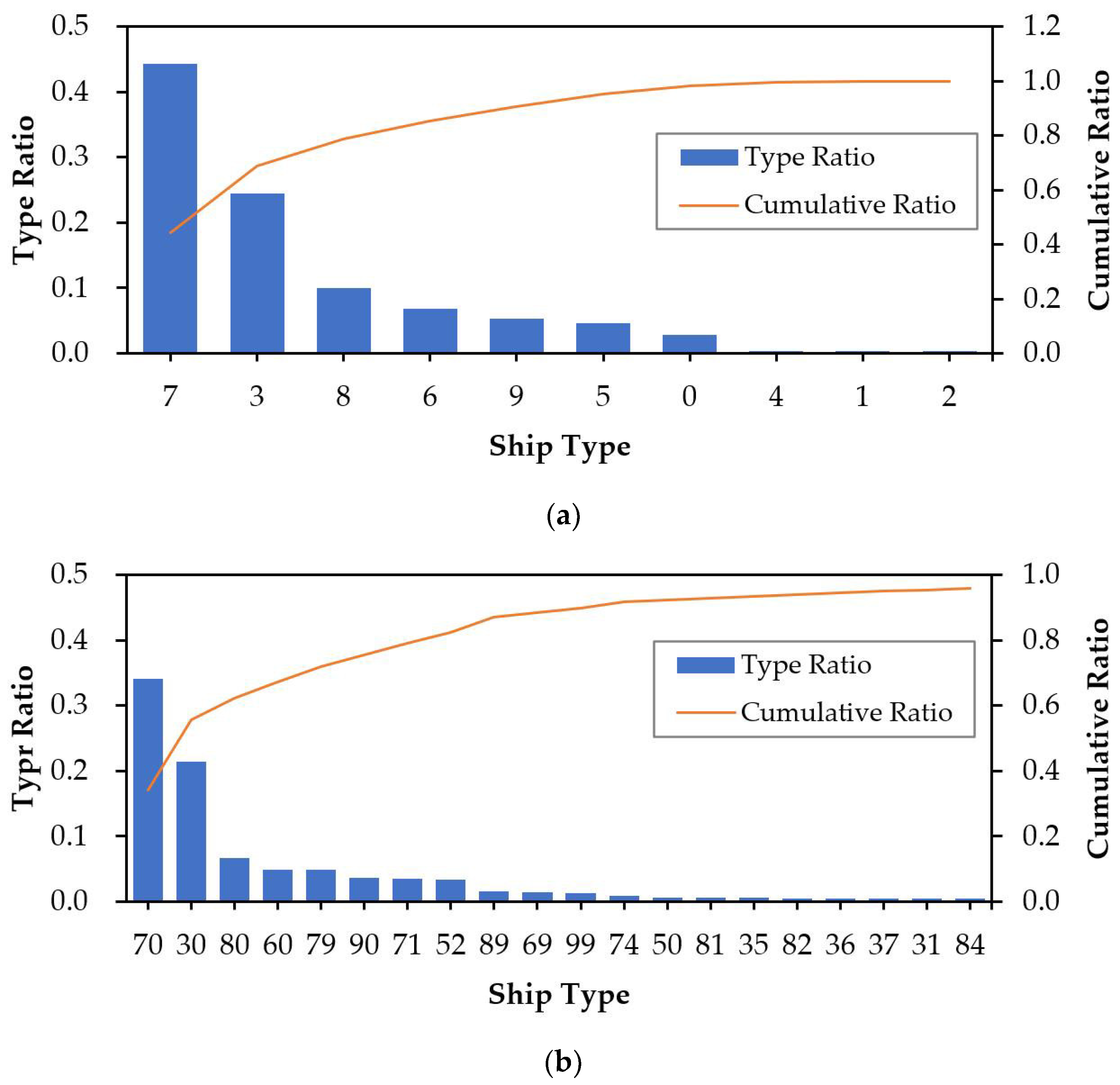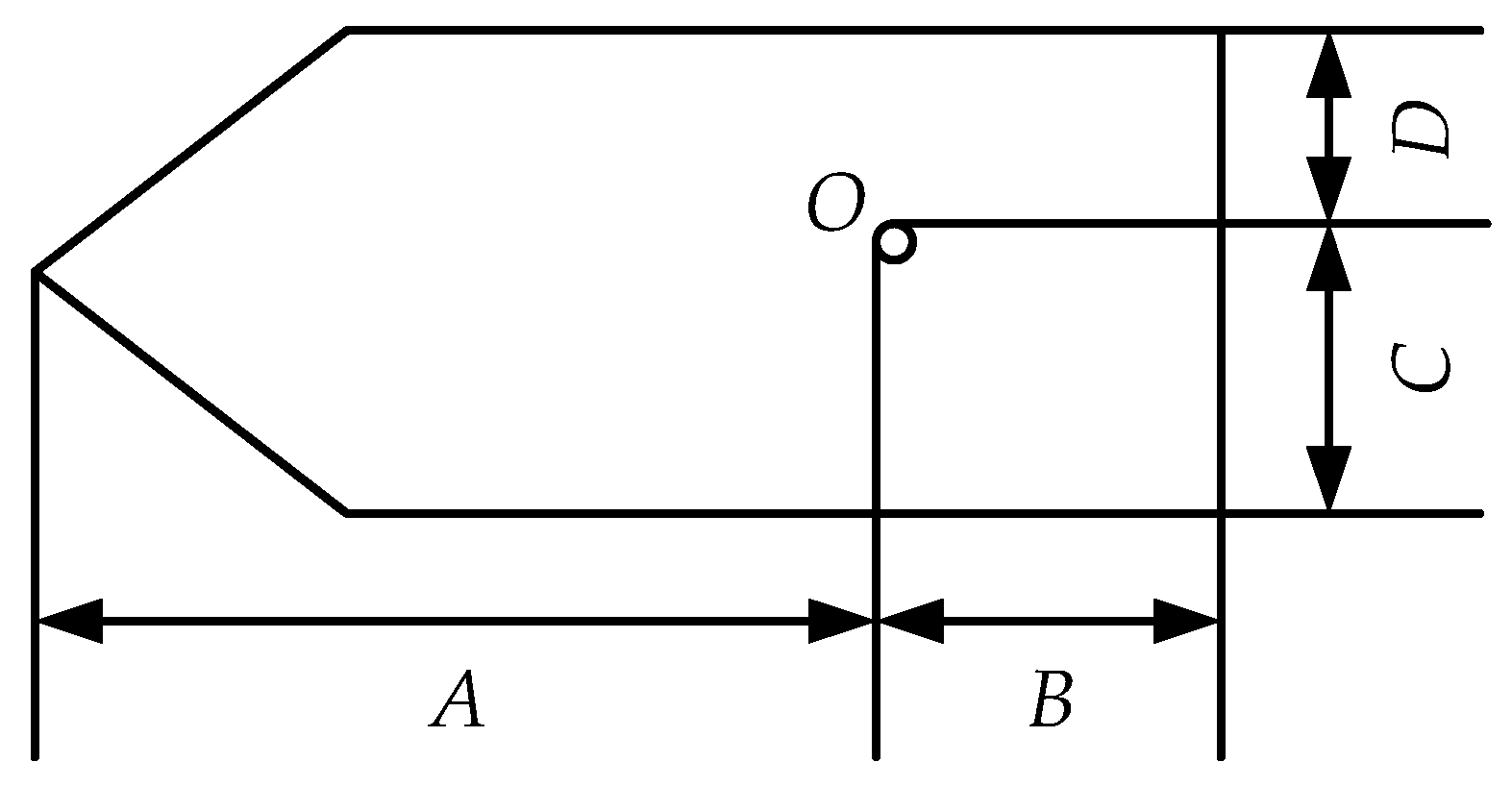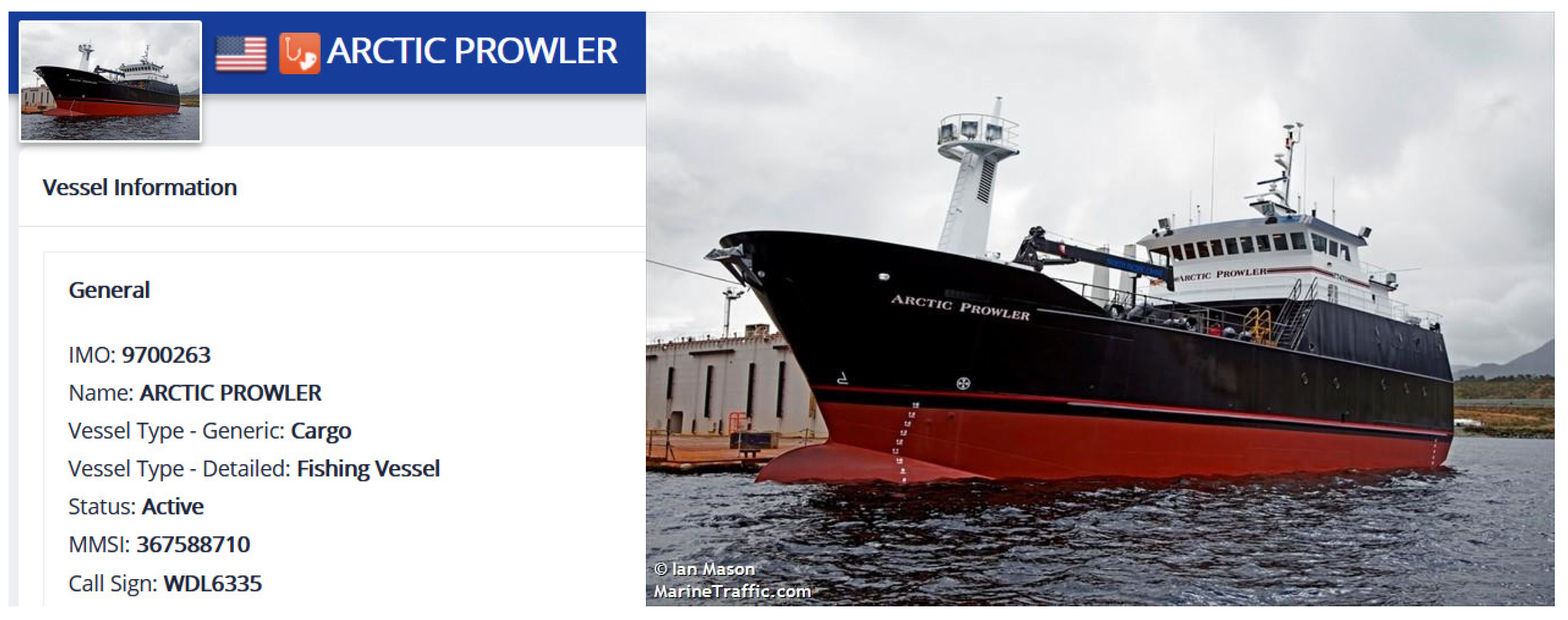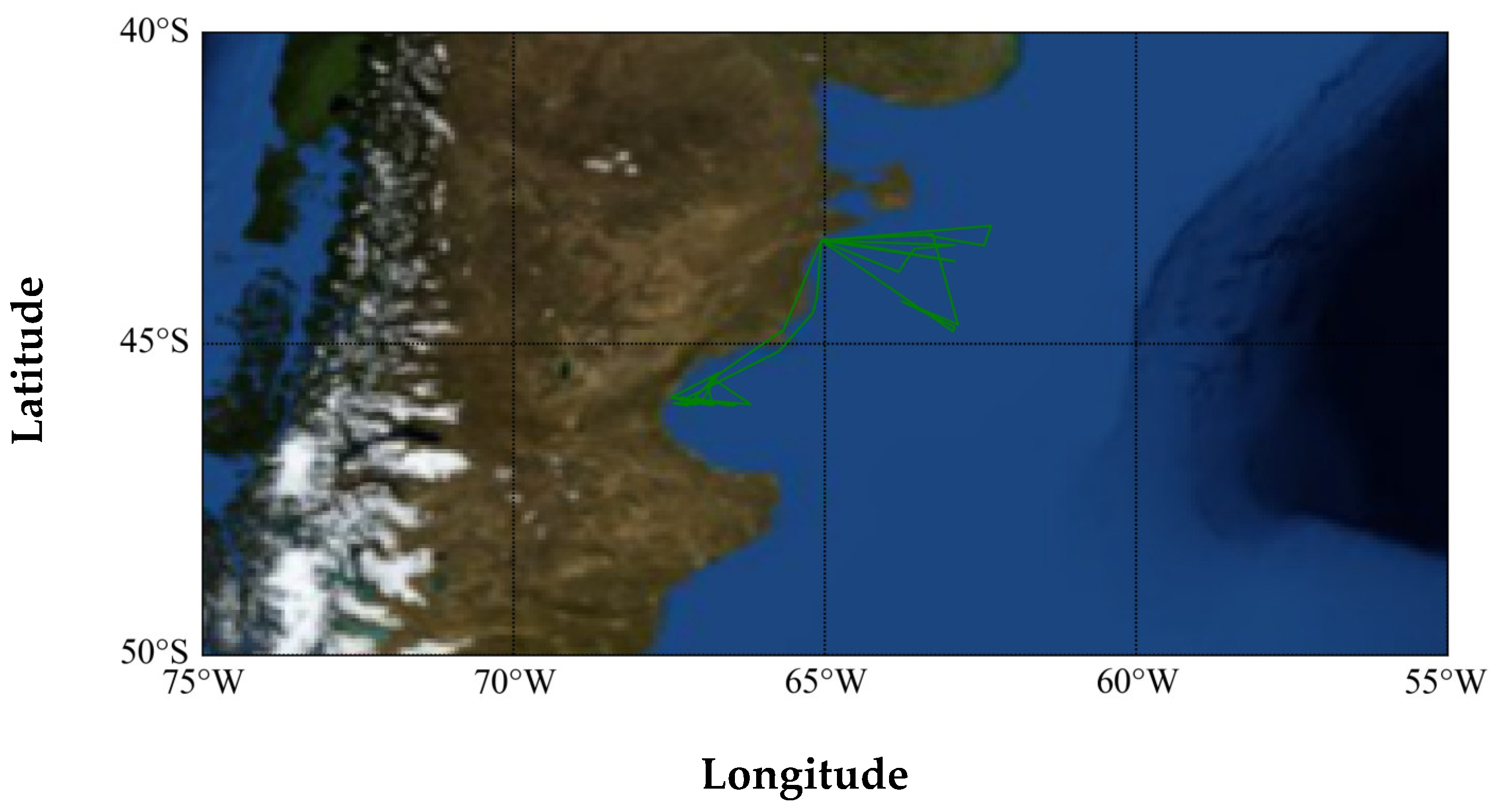Ship Classification and Anomaly Detection Based on Spaceborne AIS Data Considering Behavior Characteristics
Abstract
1. Introduction
- (i)
- In the process of ship classification and identification, we carried out a comprehensive feature extraction project on the global AIS data to form 13-dimensional features, including geometric features and behavior characteristics (course distance and sailing speed were considered), which enriches the input of classification models.
- (ii)
- We conducted research on the ship classification of spaceborne AIS data based on machine learning algorithms. The influence of different classifiers and feature combinations on the classification performance was analyzed and discussed. Experiments showed that the performance of classifiers can be improved by using the extracted behavior characteristics.
- (iii)
- Case studies of ship anomaly detection were presented and analyzed, and the experimental results demonstrate that the proposed method can effectively solve the ship anomaly detection problem in maritime surveillance.
2. Related Work
- (i)
- At present, the AIS data used for ship classification are mostly collected by shore-based AIS stations; therefore, the ship motion mode is relatively singular. This is because the coverage of shore-based AIS stations is relatively small. They can only monitor the maritime traffic situation in a specific sea area, which has certain limitations. Compared with shore-based AIS stations, spaceborne AIS receivers can realize AIS data collection worldwide and carry out large-scale offshore data mining. However, there are relatively few studies on ship behavior analysis and maritime traffic control in the open sea for spaceborne AIS.
- (ii)
- Most current studies on ship classification are focused on cargo ships and oil tankers, which account for the vast majority of ships, resulting in a relatively singular type of ship classification for AIS data. The development of maritime surveillance technology requires research on various types of ships, but relatively few studies have been conducted on passenger ships, fishing ships, and other types of ships.
- (iii)
- The existing studies mainly focus on the single geometric features of ships, and few studies consider the ship behavior characteristics, which is the necessary direction to further improve the performance of AIS ship classification.
3. Materials and Methods
3.1. AIS Data Source
3.2. AIS Data Preparation and Analysis
3.2.1. Data Preprocessing
3.2.2. Ship Type Statistics and Analysis
3.3. Ship Feature Extraction
3.3.1. Geometric Feature Extraction
3.3.2. Behavior Characteristic Extraction
4. Experimental Results and Analysis
4.1. Ship Classification Considering Geometric Features
4.2. Ship Classification Considering Geometric Features and Behavior Characteristics
4.3. Analysis of Ship Anomaly Detection Results
5. Conclusions and Future Work
Author Contributions
Funding
Institutional Review Board Statement
Informed Consent Statement
Data Availability Statement
Acknowledgments
Conflicts of Interest
References
- Pallotta, G.; Vespe, M.; Bryan, K. Vessel pattern knowledge discovery from AIS data: A framework for anomaly detection and route prediction. Entropy 2013, 15, 2218–2245. [Google Scholar] [CrossRef]
- Chuah, L.F.; Mokhtar, K.; Bakar, A.A.; Othman, M.R.; Osman, N.H.; Bokhari, A.; Mubashir, M.; Abdullah, M.A.; Hasan, M. Marine environment and maritime safety assessment using port state control database. Chemosphere 2022, 304, 135245. [Google Scholar] [CrossRef] [PubMed]
- Pan, S.; Jingbo, Y. Extracting shipping route patterns by trajectory clustering model based on automatic identification system data. Sustainability 2018, 10, 2327. [Google Scholar]
- Fournier, M.; Casey Hilliard, R.; Rezaee, S.; Pelot, R. Past, present, and future of the satellite-based automatic identification system: Areas of applications (2004–2016). WMU J. Marit. Aff. 2018, 17, 311–345. [Google Scholar] [CrossRef]
- Harati-Mokhtari, A.; Wall, A.; Brooks, P.; Jin, W. Automatic Identification System (AIS): Data reliability and human error implications. J. Navig. 2007, 60, 373–389. [Google Scholar] [CrossRef]
- Wei, Z.; Xie, X.; Zhang, X. AIS trajectory simplification algorithm considering ship behaviours. Ocean. Eng. 2020, 216, 108086. [Google Scholar] [CrossRef]
- Yan, Z.; Xiao, Y.; Cheng, L.; Chen, S.; Zhou, X.; Ruan, X.; Li, M.; He, R.; Ran, B. Analysis of global marine oil trade based on automatic identification system (AIS) data. J. Transp. Geogr. 2020, 83, 102637. [Google Scholar] [CrossRef]
- Sang, L.Z.; Wall, A.; Mao, Z.; Yan, X.P.; Wang, J. A novel method for restoring the trajectory of the inland waterway ship by using AIS data. Ocean. Eng. 2015, 110, 183–194. [Google Scholar] [CrossRef]
- Murray, B.; Perera, L.P. A dual linear autoencoder approach for vessel trajectory prediction using historical AIS data. Ocean. Eng. 2020, 209, 107478. [Google Scholar] [CrossRef]
- Liu, J.; Shi, G.; Zhu, K. Vessel trajectory prediction model based on AIS sensor data and adaptive chaos differential evolution support vector regression (ACDE-SVR). Appl. Sci. 2019, 9, 2983. [Google Scholar] [CrossRef]
- Gao, D.W.; Zhu, Y.S.; Zhang, J.F.; He, Y.K.; Yan, K.; Yan, B.R. A novel MP-LSTM method for ship trajectory prediction based on AIS data. Ocean. Eng. 2021, 228, 108956. [Google Scholar] [CrossRef]
- Liu, R.W.; Liang, M.; Nie, J.; Lim, W.Y.B.; Zhang, Y.; Guizani, M. Deep learning-powered vessel trajectory prediction for improving smart traffic services in maritime internet of things. IEEE Trans. Netw. Sci. Eng. 2022, 9, 3080–3094. [Google Scholar] [CrossRef]
- Zhang, W.; Goerlandt, F.; Montewka, J.; Kujala, P. A method for detecting possible near miss ship collisions from AIS data. Ocean. Eng. 2015, 107, 60–69. [Google Scholar] [CrossRef]
- Bakdi, A.; Glad, I.K.; Vanem, E.; Engelhardtsen, Y. AIS-based multiple vessel collision and grounding risk identification based on adaptive safety domain. J. Mar. Sci. Eng. 2019, 8, 5. [Google Scholar] [CrossRef]
- Nguyen, M.C.; Zhang, S.; Wang, X. A novel method for risk assessment and simulation of collision avoidance for vessels based on AIS. Algorithms 2018, 11, 204. [Google Scholar] [CrossRef]
- Hörteborn, A.; Ringsberg, J.W. A method for risk analysis of ship collisions with stationary infrastructure using AIS data and a ship manoeuvring simulator. Ocean. Eng. 2021, 235, 109396. [Google Scholar] [CrossRef]
- Kroodsma, D.A.; Mayorga, J.; Hochberg, T.; Miller, N.A.; Boerder, K.; Ferretti, F.; Wilson, A.; Bergman, B.; White, T.D.; Block, B.A. Tracking the global footprint of fisheries. Science 2018, 359, 904. [Google Scholar] [CrossRef]
- Zhen, R.; Jin, Y.; Hu, Q.; Shao, Z.; Nikitakos, N. Maritime anomaly detection within coastal waters based on vessel trajectory clustering and Naïve Bayes Classifier. J. Navig. 2017, 70, 648–670. [Google Scholar] [CrossRef]
- Rong, H.; Teixeira, A.P.; Soares, C.G. Data mining approach to shipping route characterization and anomaly detection based on AIS data. Ocean. Eng. 2020, 198, 106936. [Google Scholar] [CrossRef]
- Liu, B.; Zhang, W. Tracing illegal oil discharges from vessels using SAR and AIS in Bohai Sea of China. Ocean. Coast. Manag. 2021, 211, 105783. [Google Scholar] [CrossRef]
- Mccauley, D.J.; Woods, P.; Sullivan, B.; Bergman, B.; Jablonicky, C.; Roan, A.; Hirshfield, M.; Boerder, K.; Worm, B. Ending hide and seek at sea. Science 2016, 351, 1148–1150. [Google Scholar] [CrossRef] [PubMed]
- Iphar, C.; Napoli, A.; Ray, C. Detection of false AIS messages for the improvement of maritime situational awareness. In Proceedings of the Oceans 2015-MTS/IEEE Washington, Washington, DC, USA, 19–22 October 2015; pp. 1–7. [Google Scholar]
- Liang, M.; Zhan, Y.; Liu, R.W. MVFFNet: Multi-view feature fusion network for imbalanced ship classification. Pattern Recognit. Lett. 2021, 151, 26–32. [Google Scholar] [CrossRef]
- Chuah, L.F.; Mohd Salleh, N.H.; Osnin, N.A.; Alcaide, J.I.; Abdul Majid, M.H.; Abdullah, A.A.; Bokhari, A.; Jalil, E.E.A.; Klemeš, J.J. Profiling Malaysian ship registration and seafarers for streamlining future Malaysian shipping governance. Aust. J. Marit. Ocean. Aff. 2021, 13, 225–261. [Google Scholar] [CrossRef]
- Pedroche, D.S.; Amigo, D.; García, J.; Molina, J.M. Architecture for trajectory-based fishing ship classification with AIS data. Sensors 2020, 20, 3782. [Google Scholar] [CrossRef] [PubMed]
- Damastuti, N.; Aisjah, A.S.; Masroeri, A.A. Classification of ship-based automatic identification systems using k-nearest neighbors. In Proceedings of the 2019 International Seminar on Application for Technology of Information and Communication (iSemantic), Semarang, Indonesia, 21–22 September 2019; pp. 331–335. [Google Scholar]
- Sheng, K.; Liu, Z.; Zhou, D.; He, A.; Feng, C. Research on ship classification based on trajectory features. J. Navig. 2018, 71, 100–116. [Google Scholar] [CrossRef]
- Elwakdy, M.; El-Bendary, M.; Eltokhy, M. A Novel Trajectories Classification Approach for different types of ships using a Polynomial Function and ANFIS. In Proceedings of the 2015 International Conference on Image Processing, Computer Vision, & Pattern Recognition (IPCV’15), Las Vegas, NV, USA, 27–30 July 2015; p. 387. [Google Scholar]
- Zhong, H.; Song, X.; Yang, L. Vessel classification from space-based ais data using random forest. In Proceedings of the 2019 5th International Conference on Big Data and Information Analytics (BigDIA), Kunming, China, 8–10 July 2019; pp. 9–12. [Google Scholar]
- Zhou, Y.; Daamen, W.; Vellinga, T.; Hoogendoorn, S.P. Ship classification based on ship behavior clustering from AIS data. Ocean. Eng. 2019, 175, 176–187. [Google Scholar] [CrossRef]
- Kraus, P.; Mohrdieck, C.; Schwenker, F. Ship classification based on trajectory data with machine-learning methods. In Proceedings of the 2018 19th International Radar Symposium (IRS), Bonn, Germany, 20–22 June 2018; pp. 1–10. [Google Scholar]
- Wang, Y.; Yang, L.; Song, X.; Li, X. Ship classification based on random forest using static information from AIS data. In Journal of Physics: Conference Series, Proceedings of the 2021 4th International Conference on Mechatronics and Computer Technology Engineering (MCTE 2021), Xi’an, China, 15–17 October 2021; IOP Publishing: Bristol, UK, 2021; Volume 2113, p. 12072. [Google Scholar]
- Handayani, D.; Sediono, W.; Shah, A. Anomaly detection in vessel tracking using support vector machines (SVMs). In Proceedings of the 2013 International Conference on Advanced Computer Science Applications and Technologies, Kuching, Malaysia, 23–24 December 2013; pp. 213–217. [Google Scholar]
- Kowalska, K.; Peel, L. Maritime anomaly detection using Gaussian process active learning. In Proceedings of the 2012 15th International Conference on Information Fusion, Singapore, 9–12 July 2012; pp. 1164–1171. [Google Scholar]
- Mazzarella, F.; Arguedas, V.F.; Vespe, M. Knowledge-based vessel position prediction using historical AIS data. In Proceedings of the 2015 Sensor Data Fusion: Trends, Solutions, Applications (SDF), Bonn, Germany, 6–8 October 2015; pp. 1–6. [Google Scholar]
- Nguyen, D.; Vadaine, R.; Hajduch, G.; Garello, R.; Fablet, R. A multi-task deep learning architecture for maritime surveillance using AIS data streams. In Proceedings of the 2018 IEEE 5th International Conference on Data Science and Advanced Analytics (DSAA), Turin, Italy, 1–3 October 2018; pp. 331–340. [Google Scholar]
- Union, I.T. Technical Characteristics for an Automatic Identification System Using Time Division Multiple Access in the VHF Maritime Mobile Band. Available online: http://www.itu.int/rec/R-REC-M.1371/en (accessed on 20 October 2021).
- Lang, H.; Wu, S.; Xu, Y. Ship classification in SAR images improved by AIS knowledge transfer. IEEE Geosci. Remote Sens. Lett. 2018, 15, 439–443. [Google Scholar] [CrossRef]
- Cortes, C.; Vapnik, V.N. Support vector networks. Mach. Learn. 1995, 20, 273–297. [Google Scholar] [CrossRef]
- Breiman, L. Random forests. Mach. Learn. 2001, 45, 5–32. [Google Scholar] [CrossRef]
- Traffic, M. The Marine Traffic Website. Available online: http://www.marinetraffic.com (accessed on 27 October 2021).











| Satellites | Message Types | Fields Selected |
|---|---|---|
| HY-1C/HY-2B | Message 1 (dynamic information) | MMIS, Time, Time Stamp, Longitude, Latitude, SOG, A, B, C, D, Type |
| Message 2 (dynamic information) | ||
| Message 3 (dynamic information) | ||
| Message 5 (Static information) |
| Ship Subcategory Codes | Ship Types | Ship Category Codes |
|---|---|---|
| 30 | Fishing ship | 3 |
| 52 | Tug ship | 5 |
| 60–69 | Passenger ship | 6 |
| 70–79 | Cargo ship | 7 |
| 80–89 | Tanker ship | 8 |
| Geometric Features | Evaluating Indicators | Ship Types | ||||
|---|---|---|---|---|---|---|
| Cargo | Tanker | Fishing | Passenger | Tug | ||
| Length (m) | Mean value | 212.64 | 215.96 | 50.88 | 97.75 | 43.31 |
| Std. deviation | 66.66 | 70.70 | 24.82 | 82.16 | 37.68 | |
| Width (m) | Mean value | 32.73 | 36.65 | 10.36 | 16.89 | 12.56 |
| Std. deviation | 9.58 | 12.97 | 5.61 | 10.76 | 6.86 | |
| Naive_Perimeter (m) | Mean value | 490.75 | 505.21 | 122.49 | 229.23 | 111.74 |
| Std. deviation | 150.94 | 166.49 | 57.35 | 183.40 | 87.25 | |
| Naive_Area (m2) | Mean value | 7540.11 | 8795.10 | 614.26 | 2420.80 | 761.77 |
| Std. deviation | 4228.87 | 5555.35 | 914.04 | 3293.65 | 1814.57 | |
| Aspect_Ratio | Mean value | 6.48 | 5.97 | 4.94 | 5.25 | 3.29 |
| Std. deviation | 0.94 | 0.64 | 1.36 | 1.78 | 1.09 | |
| Shape_Complex | Mean value | 8.64 | 8.14 | 7.17 | 7.47 | 5.63 |
| Std. deviation | 0.92 | 0.63 | 1.27 | 1.69 | 1.01 | |
| Motion Features | Evaluating Indicators | Ship Types | ||||
|---|---|---|---|---|---|---|
| Cargo | Tanker | Fishing | Passenger | Tug | ||
| Longitude_Span (°) | Mean value | 200.21 | 166.74 | 86.49 | 69.56 | 22.16 |
| Std. deviation | 135.13 | 130.17 | 126.8 | 120.54 | 58.08 | |
| Latitude_Span (°) | Mean value | 60.01 | 53.95 | 21.16 | 29.99 | 10.42 |
| Std. deviation | 27.93 | 26.51 | 24.07 | 43.91 | 18.07 | |
| Voyage_Distance (km) | Mean value | 65,373.68 | 54,165.88 | 33,637.14 | 33,934.47 | 9440.48 |
| Std. deviation | 39,046.90 | 71,069.34 | 144,369.14 | 45,860.41 | 20,906.18 | |
| High_Speed_Mean (knot) | Mean value | 12.42 | 12.35 | 10.49 | 13.49 | 9.02 |
| Std. deviation | 3.42 | 3.18 | 10.49 | 8.64 | 8.52 | |
| High_Speed_Std (knot) | Mean value | 1.93 | 1.69 | 2.77 | 2.88 | 2.55 |
| Std. deviation | 2.10 | 1.74 | 5.64 | 3.95 | 5.65 | |
| Low_Speed_Mean (knot) | Mean value | 1.53 | 1.52 | 2.04 | 1.21 | 1.37 |
| Std. deviation | 0.95 | 0.91 | 1.02 | 0.80 | 0.89 | |
| Low_Speed_Std (knot) | Mean value | 1.15 | 1.07 | 1.07 | 1.13 | 1.19 |
| Std. deviation | 0.52 | 0.51 | 0.37 | 0.48 | 0.43 | |
| Methods | Ship Types | Evaluation Metrics | ||||
|---|---|---|---|---|---|---|
| Precision | Recall | F1-Score | Support Size | Accuracy | ||
| SVM | Cargo | 72.80% | 87.00% | 79.27% | 200 | 70.20% |
| Tanker | 82.59% | 83.00% | 82.79% | 200 | ||
| Fishing | 54.88% | 81.50% | 65.59% | 200 | ||
| Passenger | 71.30% | 38.50% | 50.00% | 200 | ||
| Tug | 78.71% | 61.00% | 68.73% | 200 | ||
| RF | Cargo | 78.07% | 89.00% | 83.18% | 200 | 73.10% |
| Tanker | 83.65% | 87.00% | 85.29% | 200 | ||
| Fishing | 56.29% | 85.00% | 67.73% | 200 | ||
| Passenger | 75.45% | 41.50% | 53.55% | 200 | ||
| Tug | 82.89% | 63.00% | 71.59% | 200 | ||
| Methods | Ship Types | Evaluation Metrics | ||||
|---|---|---|---|---|---|---|
| Precision | Recall | F1-Score | Support Size | Accuracy | ||
| SVM | Cargo | 83.72% | 90.00% | 86.75% | 200 | 87.40% |
| Tanker | 89.80% | 88.00% | 88.89% | 200 | ||
| Fishing | 83.11% | 91.00% | 86.88% | 200 | ||
| Passenger | 91.71% | 83.00% | 87.14% | 200 | ||
| Tug | 89.95% | 85.00% | 87.40% | 200 | ||
| RF | Cargo | 92.12% | 93.50% | 92.80% | 200 | 92.70% |
| Tanker | 93.78% | 90.50% | 92.11% | 200 | ||
| Fishing | 90.91% | 95.00% | 92.91% | 200 | ||
| Passenger | 95.83% | 92.00% | 93.88% | 200 | ||
| Tug | 93.91% | 92.50% | 93.20% | 200 | ||
Publisher’s Note: MDPI stays neutral with regard to jurisdictional claims in published maps and institutional affiliations. |
© 2022 by the authors. Licensee MDPI, Basel, Switzerland. This article is an open access article distributed under the terms and conditions of the Creative Commons Attribution (CC BY) license (https://creativecommons.org/licenses/by/4.0/).
Share and Cite
Yan, Z.; Song, X.; Zhong, H.; Yang, L.; Wang, Y. Ship Classification and Anomaly Detection Based on Spaceborne AIS Data Considering Behavior Characteristics. Sensors 2022, 22, 7713. https://doi.org/10.3390/s22207713
Yan Z, Song X, Zhong H, Yang L, Wang Y. Ship Classification and Anomaly Detection Based on Spaceborne AIS Data Considering Behavior Characteristics. Sensors. 2022; 22(20):7713. https://doi.org/10.3390/s22207713
Chicago/Turabian StyleYan, Zhenguo, Xin Song, Hanyang Zhong, Lei Yang, and Yitao Wang. 2022. "Ship Classification and Anomaly Detection Based on Spaceborne AIS Data Considering Behavior Characteristics" Sensors 22, no. 20: 7713. https://doi.org/10.3390/s22207713
APA StyleYan, Z., Song, X., Zhong, H., Yang, L., & Wang, Y. (2022). Ship Classification and Anomaly Detection Based on Spaceborne AIS Data Considering Behavior Characteristics. Sensors, 22(20), 7713. https://doi.org/10.3390/s22207713




